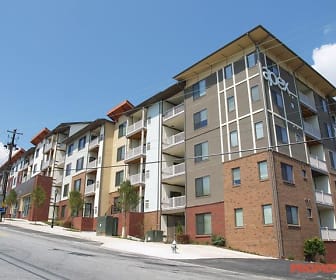
Atlanta has long struggled to provide affordable housing. The problem has grown worse as a building spree of high-rise towers has fueled a surging demand for pricey luxury units.
“There's been a limited supply of new, affordable housing,” said Marc Pollack, chairman of Pollack Shores Real Estate. “Then there's been a reduction in the existing supply of affordable housing by virtue of the fact that properties have been demolished or they've been fixed up and they're not affordable anymore.”
Even as the supply of affordable units – typically defined as units that cost no more than 30% of a household's income – has been reduced, the number of residents with limited income for rent has continued to rise, he added.
An estimated 340,400 metro Atlanta households pay over 30% of their income for housing. The region is expected to add another 50,000 households that need affordable housing during the next decade, according to an Urban Land Institute report.
To even begin meeting the need for affordable housing requires both preserving at least 5,000 existing units while constructing 5,000 more, according to Sarah Kirsch, executive director of ULI Atlanta.
The highest cost of construction is typically high-rise towers that have been popping up throughout Midtown, Buckhead and other high-density areas.
“Over the past development cycle – six or seven years – is when we saw that whole new upper luxury level of rental in Atlanta that we really hadn't experienced as a real estate market,” said Kirsch. “It's redefined the high end.”
Average monthly rents for apartments range from $1,526 in downtown Atlanta to $2,009 in Buckhead, according to a Haddow & Co. report.
High-rise luxury apartments, which can go for $8,000 to $10,000 a month, are usually built in affluent areas of the city such as Buckhead and Midtown.
“They’re typically where you've got great access to jobs, great access to healthy foods and quality health care, and they tend to be in high achieving school districts,” said Kirsch. “You want more affordability in those areas so they can grow in a more balanced way and not just become communities of the haves and have-nots.”
The growth of higher-priced units has created a trickle-down effect. Lower-priced Class B and Class C apartments have started to increase their own rental rates, as the market as a whole has become more expensive, she added.
Another factor driving affordability is that while average rents in other big cities have declined – sometimes dramatically – the cost of rental units in Atlanta has continued to rise.
The current rental vacancy rate for the Atlanta area is holding at about 6% overall. “This goes hand in hand with the fact that Atlanta rents are growing on a year-over-year basis, showing that there is a rental demand present that is keeping prices up and rental vacancy fairly low,” said Crystal Chen, spokesman with Zumper, an apartment rental marketplace and search engine.
The median rent for a one-bedroom apartment in Atlanta was $1,440, up 3% from a year ago, while a two bedroom rose 6.7% to $1,900, according to Zumper’s August 2020 Atlanta Metro Area Report.
The report analyzes active apartment listings aggregated by city to calculate median asking rents.
“Atlanta is in a unique category of cities because it is experiencing some price growth, especially since March, when a lot of these dramatic decreases have been occurring in expensive [cities],” said Neil Gerstein, an analyst with Zumper. “When we look at the Atlanta metro area, Atlanta city proper is growing faster or is growing steadily relative to the suburbs around it, which is also atypical. We're typically seeing suburbs [in other cities] outpacing city propers in growth right now.”
Both San Francisco and New York reached their lowest price points since Zumper started tracking median prices in 2014. The median one-bedroom in San Francisco was $3,040 in August, a 14.1% decrease from a year ago.
Lower-priced cities, including Atlanta, have been on the receiving end of migration from higher-priced cities.
“They are becoming new destinations for people that are moving away from places like San Francisco, New York and other historically expensive places,” said Gerstein. “That’s why we believe price growth has kept pace in places like Atlanta, Sacramento or Austin.”
Despite a city skyline often crowded with construction cranes and fast-rising towers, the total amount of housing declined relative to the influx of new residents and workers, according to Kirsch.
Contact JD Homes
For more information about the Atlanta rental market, or to speak with us about our property management services, contact us today by calling (770) 506-2630 or click here.








